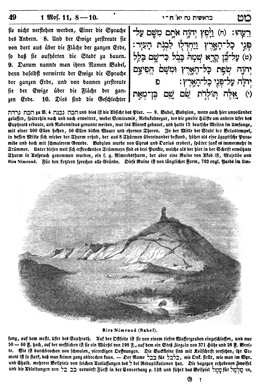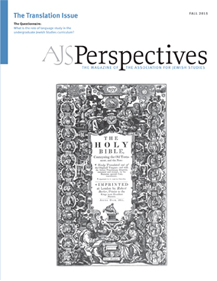
(Leipzig: Baumgartner’s Buchhandlung, 1839), 49.
That the number of German Jewish Bible translations dwarfed the number of Protestant and Catholic translations in this period is especially surprising given that Luther and the Protestant Reformation inaugurated the modern turn to Bible translation. Luther produced his translation in the early sixteenth century, and the next century witnessed an explosion of Bible translations. Jonathan Sheehan explains the role of translation in this period as a means of "releasing the Bible from the grip of the Catholic Church and at the same time, allowing reformers and their universal priesthood of believers to take possession of the Bible."
The first German Jewish Bible translation did not appear until two and half centuries after Luther's. Why? The answer in large part has to do with changes in German Jewish communal authority. With the rise of Enlightened Absolutism at the end of the eighteenth century, the institutional Jewish community (the kehillah) lost its coercive power, and Jews increasingly interacted with German Christians while striving for emancipation. Hope for emancipation confronted the reality that German Jews faced continued and sometimes increasing anti-Jewish prejudice. Advances in Jewish civil rights alternated with rollbacks. At the same time, many rabbis worried that the drive for emancipation was loosening the bonds of religious commitment as Jews were discarding age-old beliefs and practices.
The traditional German Jewish curriculum for males had centered on the Talmud. In turning to Bible translation, German Jews refocused their educational agenda on the Bible, signaling both their commonalities with German Protestants but also their differences, as they sought to present a distinctly Jewish Bible. Bible translation was a space where German met Hebrew and Jewish thinkers wrestled with aspirations, frustrations, and anxieties about emancipation by enacting different visions of the relationship between Jewish tradition and German modernity. The plethora of German Jewish Bible translations reflects the fragmentation of German Jewry as different thinkers sought to define German Judaism.
There were sixteen German Jewish Bible translations comprising at least the Pentateuch between Mendelssohn and Buber-Rosenzweig. Many were associated with important ideological formations: Mendelssohn's with Haskalah; Gotthold Salomon's, Leopold Zunz's, and Ludwig Philippson's with Wissenschaft and Reform; Jonah Kosmann's, Samson Raphael Hirsch's, and Seligmann Bamberger's with Orthodoxy; Buber and Rosenzweig's with the Return to Judaism movement.
Each translator was confronted with a myriad of choices. What to title the translation? Should the original Hebrew text be included? What about a commentary and if so, in what language? Should the names of biblical characters be translated into their German equivalent or transliterated from the Hebrew? How to translate the name of God? Should the biblical text be divided according to the weekly Torah portion? How to treat rabbinic interpretations and critical Bible scholarship?
Abigail Gillman has noted that Mendelssohn's translation strongly resembles the traditional Jewish study Bible, the Mikra'ot gedolot (lit.,"Great Scriptures"). Both include the original Hebrew text facing a translation in Hebrew characters, with commentary below. Like the Mikra'ot gedolot, Mendelssohn gives his work a Hebrew title, Sefer netivot ha-shalom (Pathways of Peace). But Mendelssohn's Bible deviates from the Mikra'ot gedolot in crucial respects. While the Mikra'ot gedolot often includes several Aramaic translations and invariably privileges the "canonical" translation of Onkelos, Mendelssohn's replaces all these translations with his own translation into High German, which he calls "Targum Ashkenaz." Similarly, the Mikra'ot gedolot incorporate several commentaries, including Rashi's seminal work, which was included in nearly all rabbinic Bibles in Mendelssohn's time. But Mendelssohn removes all commentaries, including Rashi's, and replaces them with a new commentary called the Be'ur. Addressing Jews raised largely in traditional homes, Mendelssohn's decision to replace traditional translations and commentaries with the Be'ur signals his desire to replace premodern conceptions of Judaism with a new maskilic (enlightened) one.
Leopold Zunz's Bible is entirely different. Published by the founder of the Wissenschaft des Judentums in 1838, the work that Zunz edited (he himself only translated the book of Chronicles), was the first complete German Jewish translation of all twenty-four books of the Bible. Intended for Jews no longer familiar with Yiddish or Hebrew, Zunz eliminated the Hebrew original and gave his work a German title, Die vierundzwanzig Bücher der heiligen Schrift (The twenty-four books of the Bible). Zunz's Bible was not a study Bible; it eliminated all commentary. It evinces a historical consciousness, as it includes a chronological table or Zeittafel, which mentions important events in Jewish history, giving their dates according to both the traditional rabbinic reckoning and the Gregorian calendar. When there is a conflict between the rabbinic reckoning and scholarly consensus (such as the date of the destruction of the First Temple), Zunz follows the scholarly consensus, thereby indicating his willingness to deviate from rabbinic tradition.
A historical sensibility is even more evident in Ludwig Philippson's Die Israelitische Bibel, whose first edition Philippson published between 1844 and 1854. Philippson had planned to produce the first German Jewish translation and commentary on all twenty-four books of the Bible, though Salomon Herxheimer beat him to it in 1848. Philippson's Bible includes the Hebrew original facing a translation in Gothic characters and a commentary in German sprinkled with words in Hebrew script. Philippson sought to create a Bible that would appeal to a broad spectrum of German Jews from Reform to Orthodox (hence the inclusive name), and he was especially concerned with opposing Christian missionaries who were supplying Jews with cheap Bibles. To appeal to a broad swath of Jews, Philippson adopted a fairly conservative approach to source and text-critical questions; for example, he accepted Mosaic authorship of the Torah and polemicized against an array of Bible critics. But Philippson retained a historical sensibility and accepted elements of biblical criticism. He allowed that certain biblical passages may have been interpolated later, and would often interpret the Bible in ways that contradicted accepted rabbinic law. In addition, he sought to set the Bible in its ancient Near Eastern context by including thousands of exquisite woodcuts that emphasized this imagery. In this way, Philippson used history to make the Bible vivid. Philippson's Bible was an enormous success. According to some reports, there were as many as 300,000 Philippson Bibles in circulation by 1866.
Samson Raphael Hirsch's Bible, published between 1867 and 1878, was in many ways intended as an alternative to Philippson's. The format of Hirsch's Bible mirrored Philippson's almost exactly: Hebrew original, German translation in Gothic characters, and German commentary interspersed with Hebrew words. While Orthodox, Hirsch, unlike Mendelssohn, published his commentary in German and his translation in Gothic characters. This shows that by Hirsch's time, even Orthodox Jews were much more acculturated, and native knowledge of German was assumed. Opposing Philippson, Hirsch's aim was to present a Bible outside of history, as a revelation in which the Oral Law (itself Sinaitic) constituted the Bible's definitive interpretation. Seeing the Torah, both oral and written, as timeless, Hirsch eschewed all comparative philology, instead originating a novel account of Hebrew etymology based on phonetic similarity and letter interchange that linked Hebrew roots conceptually. For example, in his commentary on Genesis 1:1, Hirsch noted that the word root ב.ר.א (to create) is cognate with פ.ר.ח (to flower), and ב.ר.ח (to flee), all connoting "striving to get out or getting out of a state of being constrained." Thus, Hirsch interprets ברא in Genesis 1:1 as meaning that God brought "something into reality, which had hitherto existed only inwardly in the mind."
Finally, Buber and Rosenzweig's Bible sought to return an oral sensibility to the Bible. They noted that while the standard German term for the Bible, Schrift, means "writing," the Hebrew word for the Bible is mikrah, from the root קרא , meaning "call." Buber and Rosenzweig thus presented a Bible that was supposed to be read by dividing it into breathing colons. Including only the biblical text in German on a clean white page, with verse numbers placed inconspicuously in the upper corner of the page, Buber and Rosenzweig sought to create a direct, immediate, revelatory encounter between the reader and the word of God. Writing for Jews who did not know Hebrew, they aimed to convey a sense of the Hebrew to the German reader by coining German neologisms that preserved roots in Hebrew, which Buber and Rosenzweig called Leitwörter or leading words. They likewise sought to reproduce the repetition between verb and noun that occurs in Hebrew. Thus they rendered Genesis 37:5, ויחלם יוסף חלום , as Josef träumte einen Traum ("Joseph dreamed a dream") rather than Mendelssohn's more colloquial Einst hatte Josef einen Traum ("Once Joseph had a dream"). They also translated in ways that emphasized the embodied expressions used in Hebrew as a way of highlighting that revelation was an encounter that embraced the entire self, body and soul. It was not limited to the synagogue but encompassed one's entire life. For example, they indicated the embodied nature of revelation by translating רוח אלוהים as Braus Gottes ("breath of God") rather than the more typical Geist Gottes ("spirit of God").
Seeking to define their place in German society, Jews wrestled with the question of what they shared both with Protestants and other Jews and what differentiated them. Encountering an environment in which Jewish communal unity was fracturing and adherence to Jewish tradition was becoming voluntary, Bible translation was a vehicle through which writers presented competing visions of what it meant to be a modern German Jew.

